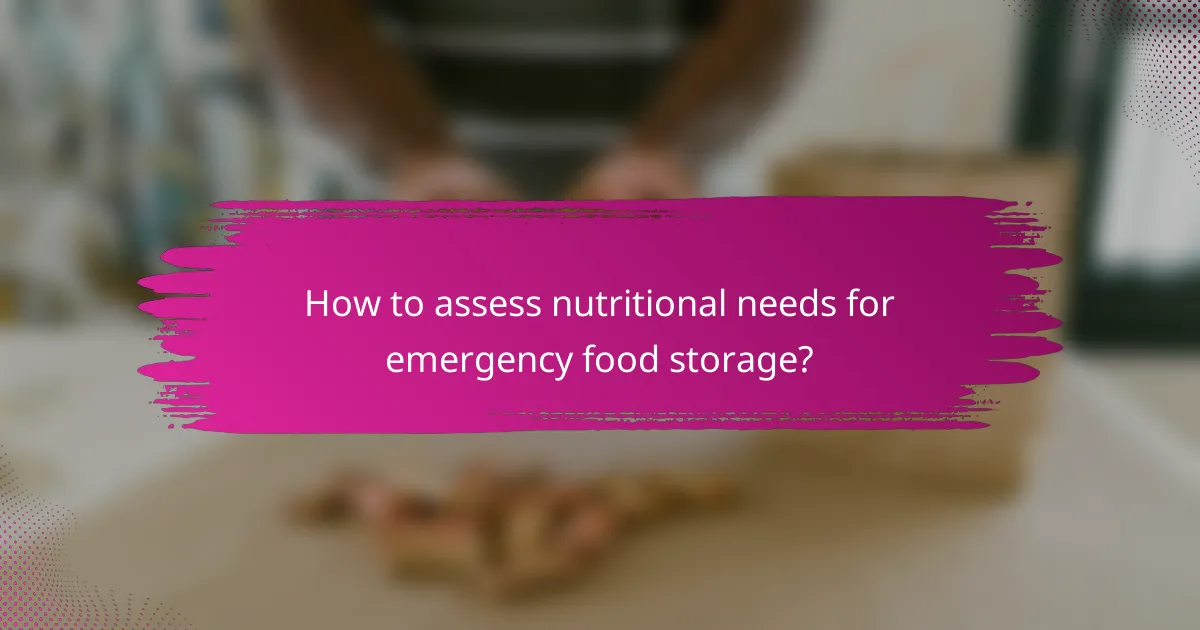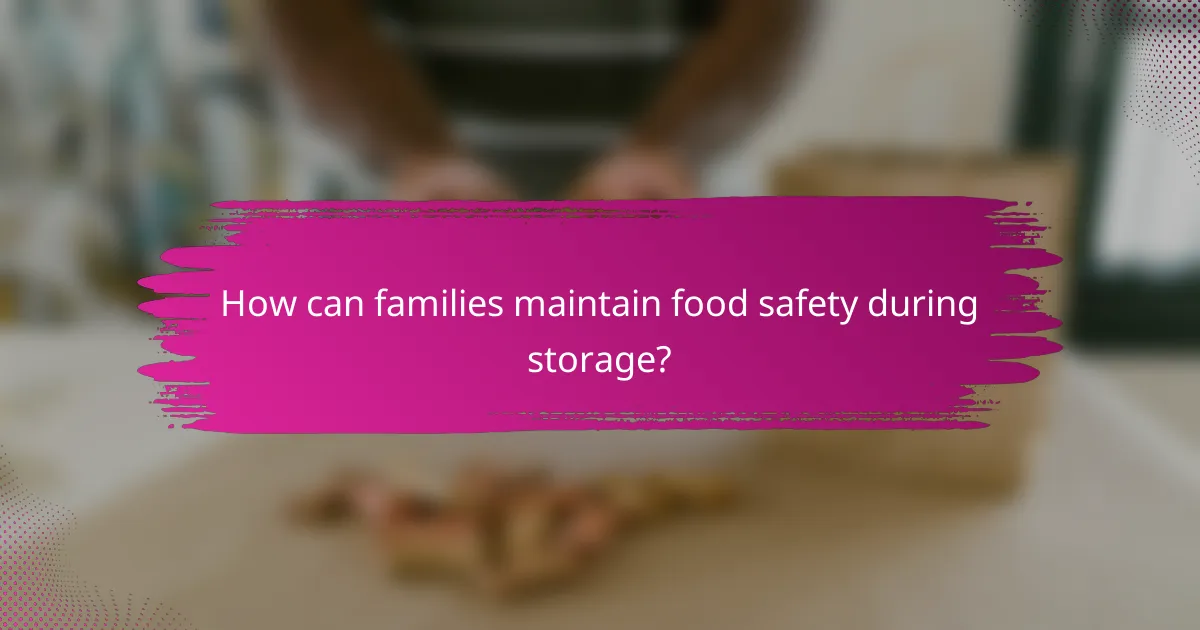Creating a family food storage plan is essential for emergency preparedness, ensuring that your household is equipped with nutritious options that meet your specific needs and budget. By assessing dietary requirements and implementing effective budgeting strategies, families can build a sustainable food supply that remains accessible and balanced during unforeseen circumstances. Tailoring your food storage solutions to potential emergencies will provide peace of mind and security for your loved ones.

What are the best family food storage solutions for emergencies?
The best family food storage solutions for emergencies include options that ensure long-term preservation, easy access, and nutritional adequacy. These solutions should be tailored to your family’s needs and budget while considering the types of emergencies you may face.
Long-term food storage options
Long-term food storage options typically include canned goods, dry grains, legumes, and freeze-dried meals. These items can last for several years when stored properly in a cool, dry place. Consider using airtight containers to protect against moisture and pests.
Common choices for long-term storage are rice, beans, pasta, and canned vegetables. Aim for a variety of foods to cover different nutritional needs and preferences.
Emergency meal kits
Emergency meal kits are pre-packaged food supplies designed for quick preparation during a crisis. They often include a mix of dehydrated meals, snacks, and essential items like water purification tablets. Look for kits that provide balanced nutrition and cater to dietary restrictions.
When selecting meal kits, consider the shelf life, ease of preparation, and portion sizes. Some kits can last for up to 25 years, making them a reliable choice for long-term preparedness.
Vacuum sealing techniques
Vacuum sealing is an effective method for preserving food by removing air from packaging, which helps prevent spoilage and freezer burn. This technique is suitable for various foods, including meats, vegetables, and dry goods. Invest in a quality vacuum sealer for best results.
When vacuum sealing, ensure that food is fresh and dry before sealing. Label packages with dates and contents to keep track of storage times and avoid confusion.
Freeze-dried food brands
Freeze-dried food brands offer lightweight, nutritious options that are ideal for emergency storage. These foods retain most of their nutrients and flavor, making them a popular choice for families preparing for emergencies. Brands like Mountain House and Wise Company are well-regarded in this category.
When choosing freeze-dried foods, check the ingredient list for additives and preservatives. Look for options that provide a good balance of carbohydrates, proteins, and fats.
Bulk purchasing strategies
Bulk purchasing can significantly reduce costs when stocking up on emergency food supplies. Buy non-perishable items in larger quantities from wholesale retailers or online stores to take advantage of discounts. Focus on staple foods that have a long shelf life.
Consider joining a local food co-op or group buying club to access bulk deals. Always check expiration dates and rotate your stock to ensure freshness.

How to assess nutritional needs for emergency food storage?
Assessing nutritional needs for emergency food storage involves understanding the essential nutrients your family requires and ensuring you have a balanced supply. This process includes evaluating dietary guidelines and considering the specific needs of each family member.
Essential nutrients for families
Families need a variety of essential nutrients to maintain health, including carbohydrates, proteins, fats, vitamins, and minerals. Carbohydrates provide energy, while proteins are crucial for growth and repair. Healthy fats support brain function, and vitamins and minerals play vital roles in numerous bodily processes.
When planning your emergency food storage, prioritize foods rich in these nutrients. For example, whole grains, legumes, nuts, seeds, fruits, and vegetables should be staples in your storage plan.
Recommended daily allowances
Recommended daily allowances (RDAs) vary by age, gender, and activity level, but general guidelines can help you plan. For instance, adults typically need around 46-56 grams of protein daily, while children require less, depending on their age. It’s essential to adjust these figures based on individual health needs and dietary restrictions.
Consult resources like the Dietary Guidelines for Americans or local health authorities to determine specific RDAs for your family. Keeping a record of these allowances can help ensure you meet everyone’s nutritional needs during emergencies.
Food variety for balanced diets
A diverse food supply is crucial for a balanced diet, especially during emergencies. Aim to include a range of food groups in your storage, such as grains, proteins, fruits, and vegetables. This variety helps ensure that you cover all essential nutrients and reduces the risk of dietary deficiencies.
Consider rotating your food supplies regularly to maintain freshness and prevent waste. Incorporating different flavors and textures can also make meals more enjoyable, which is important for morale during challenging times. Aim for a mix of canned, dried, and freeze-dried options to enhance your food variety.

What budgeting strategies can optimize food storage plans?
Effective budgeting strategies for food storage plans focus on maximizing resources while ensuring nutritional needs are met. By prioritizing cost-effective methods and planning purchases, families can build a sustainable emergency food supply without overspending.
Cost-effective food storage methods
Cost-effective food storage methods include using airtight containers, vacuum sealing, and freezing. These techniques help preserve food quality and extend shelf life, reducing waste and the need for frequent purchases.
Consider investing in reusable containers or bags that can be used for multiple storage needs. This not only saves money but also minimizes environmental impact.
Monthly budgeting for emergency supplies
Establishing a monthly budget for emergency supplies is crucial for maintaining a well-stocked food storage plan. Allocate a specific portion of your grocery budget—typically around 10-15%—to build your emergency stock gradually.
Track your spending and adjust as necessary, ensuring you prioritize essential items like grains, canned goods, and dried fruits. This method allows you to spread costs over time while ensuring you have adequate supplies on hand.
Discount grocery stores for bulk buying
Discount grocery stores are excellent for bulk buying, offering lower prices on staple items. Look for stores that specialize in bulk goods or have a clearance section for additional savings.
When purchasing in bulk, focus on non-perishable items such as rice, pasta, and canned vegetables. This approach not only reduces costs but also ensures you have a variety of foods available for emergencies.

What are the prerequisites for an effective food storage plan?
An effective food storage plan requires careful consideration of space, inventory management, and nutritional needs. Establishing these prerequisites ensures that your family is prepared for emergencies while maintaining a balanced diet and staying within budget.
Space requirements for storage
Assessing space requirements is crucial for a successful food storage plan. Identify areas in your home that can accommodate food supplies, such as basements, pantries, or closets. Aim for a space that is cool, dry, and dark to prolong the shelf life of stored items.
Consider the volume of food you plan to store. A family of four might need around 100-200 gallons of storage space for a three-month supply of essentials. Use shelving units or bins to maximize vertical space and keep items organized.
Inventory management systems
Implementing an inventory management system helps track food supplies and expiration dates. Use a simple spreadsheet or a dedicated app to log items, quantities, and purchase dates. Regularly update this inventory to avoid waste and ensure you have necessary items on hand.
Establish a rotation system, such as FIFO (first in, first out), to use older items before newer ones. This practice minimizes spoilage and keeps your food storage fresh. Regularly check your inventory every few months to adjust your plan based on consumption and changing needs.

How can families maintain food safety during storage?
Families can maintain food safety during storage by following proper guidelines for temperature control and tracking expiration dates. These practices help prevent foodborne illnesses and ensure that food remains nutritious and safe to consume.
Temperature control guidelines
Maintaining the right temperature is crucial for food safety. Refrigerators should be set at or below 4°C (40°F), while freezers should be at -18°C (0°F) or lower. Regularly check appliance thermometers to ensure these temperatures are consistently maintained.
When storing food, avoid overcrowding shelves to allow for proper air circulation. Additionally, store raw meats on the bottom shelf to prevent juices from contaminating other foods. Use a food thermometer to check the internal temperature of cooked items, ensuring they reach safe levels, typically above 74°C (165°F).
Expiration date tracking
Tracking expiration dates is essential for ensuring food safety and minimizing waste. Familiarize yourself with the difference between “sell by,” “use by,” and “best before” dates to make informed decisions about food consumption. Generally, “use by” dates indicate when food is no longer safe to eat.
Implement a simple system for tracking expiration dates, such as labeling containers with purchase dates or using a checklist. Regularly review your pantry and refrigerator to discard expired items and prioritize consuming foods that are nearing their expiration dates. This practice not only enhances safety but also helps manage your grocery budget effectively.

